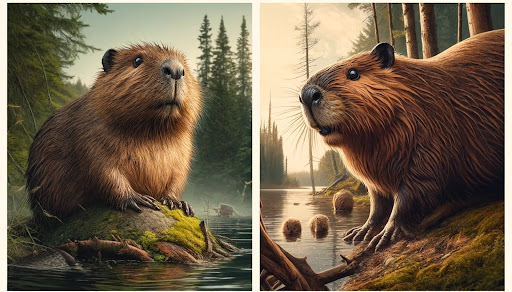The Unsung Engineers of Nature: A Closer Look at Beavers
By: Assaf Levy, BioDB
Celebrated annually on April 7th, International Beaver Day serves as a crucial extension of the themes explored in our discussion on beavers, emphasizing the significance of these ecosystem engineers in enhancing biodiversity, water management, and habitat creation. This commemorative day not only deepens our appreciation for beavers’ ecological contributions but also highlights the urgent need for their conservation and the challenges they face, such as habitat loss and human conflict.
Pexels | CC0
Often overlooked, these industrious creatures play a pivotal role in the preservation and creation of wetlands, acting as natural engineers that shape our environment in ways that benefit countless other species, including humans. With a legacy that stretches back millions of years, beavers are not just survivors; they are influencers of the world around them, transforming landscapes and ecosystems with nothing but teeth and determination. This article embarks on a journey to uncover the fascinating world of beavers, aiming to bring you closer to understanding these remarkable animals that shape the ecosystems they inhabit.
There are two distinct species of beavers that roam the forests and waterways of our planet: the North American beaver (Castor canadensis) and the Eurasian beaver (Castor fiber). The North American beaver, found in Canada, the United States, and parts of northern Mexico, boasts a population that is currently thriving, with estimates ranging from 6 to 15 million individuals. This resurgence is a testament to successful conservation efforts, as their numbers had previously plummeted due to overhunting in the 19th and early 20th centuries. On the other hand, the Eurasian beaver has carved out its domain across parts of Europe and Asia. With a population that was once on the brink of extinction, numbering as low as 1,200 individuals, rigorous protection and reintroduction programs have bolstered their numbers to approximately 1 million.
The Eurasian and North American beavers, while similar in many aspects, exhibit distinct physical differences that set them apart. The Eurasian beaver tends to have a more narrowly shaped skull and a less pronounced tail than its North American counterpart. Additionally, the Eurasian species typically boasts lighter fur and smaller, less webbed hind feet. In contrast, the North American beaver is noted for its larger, more webbed hind feet and broader, paddle-shaped tail, which it uses effectively for swimming and constructing its habitat. Both species share dense brown fur, which aids in insulation, but subtle variations in color and texture can be observed, reflecting their adaptation to different environments across continents. These physical distinctions, though slight, underscore the evolutionary paths these species have taken, adapting over millennia to thrive in their respective habitats.
Left: Eurasian beaver, Right: North American beaver
Despite their significant recovery, both species face ongoing threats that could jeopardize their populations. Habitat loss due to urban development, agriculture, and forestry poses the most significant risk. Additionally, climate change introduces new challenges, altering water levels and affecting the vegetation that beavers depend on for food and dam construction. While both species are currently listed as “Least Concern” by the IUCN Red List, indicating that they are not presently at significant risk of extinction, their situation underscores a delicate balance. The health of beaver populations is inextricably linked to the health of the wetlands and aquatic systems they help create and maintain.
Beavers are renowned for their ability to build dams, a skill that showcases their role as ecosystem engineers. These constructions are not just impressive feats of natural architecture; they serve critical ecological functions. By building dams, beavers create wetlands—biodiverse habitats that support a wide array of species, from fish and amphibians to birds and mammals. These wetlands also act as natural water purification systems, filtering pollutants and improving water quality. Furthermore, beaver dams help regulate water flow, reducing the impact of floods and droughts, which is increasingly important in the face of climate change.
Yet, the relationship between humans and beavers has been fraught with conflict. Beaver dams can sometimes cause flooding in areas used by humans, leading to the destruction of property and agricultural lands. In some regions, this has prompted the removal of beavers or the destruction of their dams. However, there’s a growing recognition of the ecological benefits beavers bring, and many communities are now exploring coexistence strategies. These include the installation of “beaver deceivers” and other flow devices that prevent flooding while allowing beavers to continue their beneficial activities.
Beaver conservation efforts have transitioned significantly over the years, moving from reactive measures to proactive, holistic strategies to preserve these keystone species and their habitats. Initially, conservation focused on regulating trapping and hunting to protect dwindling beaver populations from extinction. This was complemented by reintroduction programs that brought beavers back to regions where they had been eradicated, such as various parts of Europe, including a notable reintroduction in Scotland after a 400-year absence. Today’s ongoing efforts are multifaceted, encompassing habitat restoration projects that not only reintroduce beavers to suitable environments but also enhance existing ones to support their populations. Innovative conflict mitigation strategies, like the installation of flow devices, have been developed to resolve tensions between beaver activity and human interests, thereby fostering coexistence. Legal protections now safeguard beavers in many areas, helping manage their populations sustainably.
The story of beavers is one of resilience and ecological significance. These creatures are not just survivors from another age; they are active participants in shaping our world, creating habitats that support life in abundant forms. As we move forward, it’s clear that the fate of beavers is deeply entwined with our own. Protecting these natural engineers and the habitats they create is not just an act of conservation; it’s a recognition of the intricate connections that sustain life on our planet. In embracing beavers, we embrace a vision of a world where humans and nature thrive together, bound by the mutual benefits of a healthy, functioning ecosystem.





